Research on the Mechanism of Multi-Domain Coupling Centrifugal Electrostatic Blowing Flying Deposition
Abstract
:1. Introduction
2. Analysis of the Forming Mechanism of the Centrifugal Electrostatic Blowing Process
2.1. Design and Numerical Simulation of Centrifugal Electrostatic Blowing Experiment Platform
2.2. Model Construction of Centrifugal Electrostatic Blowing Process Based on Centrifugal Rotor Platform
2.3. Simulation Experiment Analysis Based on Numerical Model of Centrifugal Electrostatic Blowing Process
3. Experimental Verification and Analysis
3.1. Experimental Platform Design and Implementation
3.2. Experimental Results and Analysis
4. Conclusions
Author Contributions
Funding
Institutional Review Board Statement
Informed Consent Statement
Data Availability Statement
Conflicts of Interest
References
- Kenry; Lim, C.T. Nanofiber technology: Current status and emerging developments. Prog. Polym. Sci. 2017, 70, 1–17. [Google Scholar] [CrossRef]
- Kenry; Lim, C.T. Synthesis, optical properties, and chemical–biological sensing applications of one-dimensional inorganic semiconductor nanowires. Prog. Mater. Sci. 2013, 58, 705–748. [Google Scholar] [CrossRef]
- Liu, W.; Yeh, Y.C.; Lipner, J.; Xie, J.; Sung, H.W.; Thomopoulos, S.; Xia, Y. Enhancing the stiffness of electrospun nanofiber scaffolds with a controlled surface coating and mineralization. Langmuir 2011, 27, 9088–9093. [Google Scholar] [CrossRef]
- Lu, F.; Wang, J.; Chang, Z.; Zeng, J. Uniform deposition of Ag nanoparticles on ZnO nanorod arrays grown on polyimide/Ag nanofibers by electrospinning, hydrothermal, and photoreduction processes. Mater. Des. 2019, 181, 108069. [Google Scholar] [CrossRef]
- Nehra, M.; Dilbaghi, N.; Marrazza, G.; Kaushik, A.; Abolhassani, R.; Mishra, Y.K.; Kim, K.H.; Kumar, S. 1D semiconductor nanowires for energy conversion, harvesting and storage applications. Nano Energy 2020, 76, 104991. [Google Scholar] [CrossRef]
- Tian, D.; Song, N.; Zhong, M.; Lu, X.; Wang, C. Bimetallic MOF Nanosheets Decorated on Electrospun Nanofibers for High-Performance Asymmetric Supercapacitors. ACS Appl. Mater. Interfaces 2020, 12, 1280–1291. [Google Scholar] [CrossRef] [PubMed]
- Alfaro De Prá, M.A.; Ribeiro-do-Valle, R.M.; Maraschin, M.; Veleirinho, B. Effect of collector design on the morphological properties of polycaprolactone electrospun fibers. Mater. Lett. 2017, 193, 154–157. [Google Scholar] [CrossRef]
- Cai, X.; Zhu, P.; Lu, X.; Liu, Y.; Lei, T.; Sun, D. Electrospinning of very long and highly aligned fibers. J. Mater. Sci. 2017, 52, 14004–14010. [Google Scholar] [CrossRef]
- Zhou, Y.; Hu, Z.; Du, D.; Tan, G.Z. The effects of collector geometry on the internal structure of the 3D nanofiber scaffold fabricated by divergent electrospinning. Int. J. Adv. Manuf. Technol. 2018, 100, 3045–3054. [Google Scholar] [CrossRef]
- Jiang, J.; Zheng, G.; Wang, X.; Li, W.; Kang, G.; Chen, H.; Guo, S.; Liu, J. Arced Multi-Nozzle Electrospinning Spinneret for High-Throughput Production of Nanofibers. Micromachines 2019, 11, 27. [Google Scholar] [CrossRef] [Green Version]
- SalehHudin, H.S.; Mohamad, E.N.; Mahadi, W.N.L.; Muhammad Afifi, A. Multiple-jet electrospinning methods for nanofiber processing: A review. Mater. Manuf. Processes 2017, 33, 479–498. [Google Scholar] [CrossRef]
- Deitzel, J.M.; Kleinmeyer, J.; Harris, D.; Tan, N.B. The effect of processing variables on the morphology of electrospun nanofibers and textiles. Polymer 2001, 42, 261–272. [Google Scholar] [CrossRef]
- Jia, Y.-T.; Gong, J.; Gu, X.-H.; Kim, H.-Y.; Dong, J.; Shen, X.-Y. Fabrication and characterization of poly (vinyl alcohol)/chitosan blend nanofibers produced by electrospinning method. Carbohydr. Polym. 2007, 67, 403–409. [Google Scholar] [CrossRef]
- Koski, A.; Yim, K.; Shivkumar, S. Effect of molecular weight on fibrous PVA produced by electrospinning. Mater. Lett. 2004, 58, 493–497. [Google Scholar] [CrossRef]
- Megaraj, M.; Keppannan, M. Fabrication of a Superhydrophobic Nanofibers by Electrospinning; IntechOpen: London, UK, 2018. [Google Scholar]
- Meng, Z.X.; Zheng, W.; Li, L.; Zheng, Y.F. Fabrication and characterization of three-dimensional nanofiber membrance of PCL–MWCNTs by electrospinning. Mater. Sci. Eng. C 2010, 30, 1014–1021. [Google Scholar] [CrossRef]
- Park, J.-S. Electrospinning and its applications. Adv. Nat. Sci. Nanosci. Nanotechnol. 2011, 1, 043002. [Google Scholar] [CrossRef] [Green Version]
- Varesano, A.; Carletto, R.A.; Mazzuchetti, G. Experimental investigations on the multi-jet electrospinning process. J. Mater. Processing Technol. 2009, 209, 5178–5185. [Google Scholar] [CrossRef]
- Zhang, X.; Lu, Y. Centrifugal Spinning: An Alternative Approach to Fabricate Nanofibers at High Speed and Low Cost. Polym. Rev. 2014, 54, 677–701. [Google Scholar] [CrossRef]
- Brown, T.D.; Dalton, P.D.; Hutmacher, D.W. Direct writing by way of melt electrospinning. Adv. Mater. 2011, 23, 5651–5657. [Google Scholar] [CrossRef]
- Huang, Z.-M.; Zhang, Y.Z.; Kotaki, M.; Ramakrishna, S. A review on polymer nanofibers by electrospinning and their applications in nanocomposites. Compos. Sci. Technol. 2003, 63, 2223–2253. [Google Scholar] [CrossRef]
- Liu, Y.; He, J.-H. Bubble electrospinning for mass production of nanofibers. Int. J. Nonlinear Sci. Numer. Simul. 2007, 8, 393–396. [Google Scholar] [CrossRef]
- Zhang, Z.-M.; Duan, Y.-S.; Xu, Q.; Zhang, B. A review on nanofiber fabrication with the effect of high-speed centrifugal force field. J. Eng. Fibers Fabr. 2019, 14, 1558925019867517. [Google Scholar] [CrossRef] [Green Version]
- Hou, T.; Li, X.; Lu, Y.; Yang, B. Highly porous fibers prepared by centrifugal spinning. Mater. Des. 2017, 114, 303–311. [Google Scholar] [CrossRef]
- Noroozi, S.; Taghavi, S.M. Ultrafine Nanofiber Formation by Centrifugal Spinning; De Gruyter: Berlin, Germany, 2020. [Google Scholar]
- Atıcı, B.; Ünlü, C.H.; Yanilmaz, M. A Review on Centrifugally Spun Fibers and Their Applications. Polym. Rev. 2021, 62, 1–64. [Google Scholar] [CrossRef]
- Duan, Y.; Zhang, Z.; Lu, B.; Chen, B.; Lai, Z. The movement and forces of spinning solution in the nozzle during high-speed centrifugal spinning. J. Eng. Fibers Fabr. 2019, 14, 1558925019828207. [Google Scholar] [CrossRef] [Green Version]
- Hashemi, A.R.; Pishevar, A.R.; Valipouri, A.; Părău, E.I. Numerical and experimental study on the steady cone-jet mode of electro-centrifugal spinning. Phys. Fluids 2018, 30, 017103. [Google Scholar] [CrossRef] [Green Version]
- Sun, J.; Zhang, Z.; Lu, B.; Mei, S.; Xu, Q.; Liu, F. Research on parametric model for polycaprolactone nanofiber produced by centrifugal spinning. J. Braz. Soc. Mech. Sci. Eng. 2018, 40, 186. [Google Scholar] [CrossRef]
- Zou, W.; Chen, R.Y.; Zhang, G.Z.; Zhang, H.C.; Qu, J.P. Recent Advances in Centrifugal Spinning Preparation of Nanofibers. Adv. Mater. Res. 2014, 1015, 170–176. [Google Scholar] [CrossRef]
- Diring, A.; Fromme, L.; Petry, M.; Weizel, E. Comparison Between COMSOL Multiphysics® and STAR-CCM+® Simulation Results and Experimentally Determined Measured Data for a Venturi Tube. In Proceedings of the Excerpt from the Proceedings of the 2017 COMSOL Conference in Rotterdam, Rotterdam, The Netherlands, 18–20 October 2017. [Google Scholar]
- Rial, R.; Hassan, N.; Liu, Z.; Ruso, J.M. The design and green nanofabrication of noble hydrogel systems with encapsulation of doped bioactive hydroxyapatite toward sustained drug delivery. J. Mol. Liq. 2021, 343, 117598. [Google Scholar] [CrossRef]
- Rial, R.; Tahoces, P.G.; Hassan, N.; Cordero, M.; Liu, Z.; Ruso, J.M. Noble microfluidic system for bioceramic nanoparticles engineering. Mater. Sci. Eng. C 2019, 102, 221–227. [Google Scholar] [CrossRef]
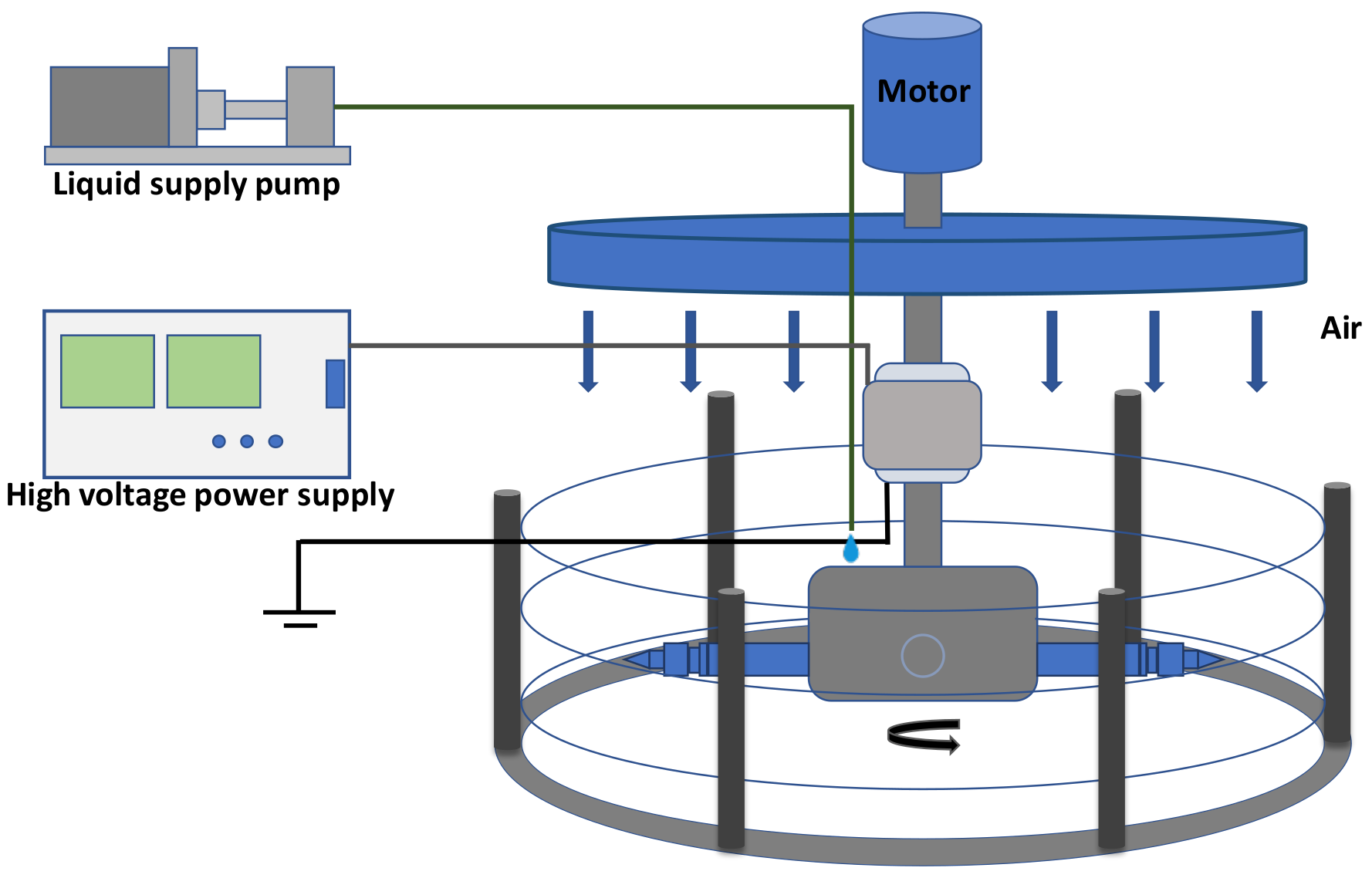
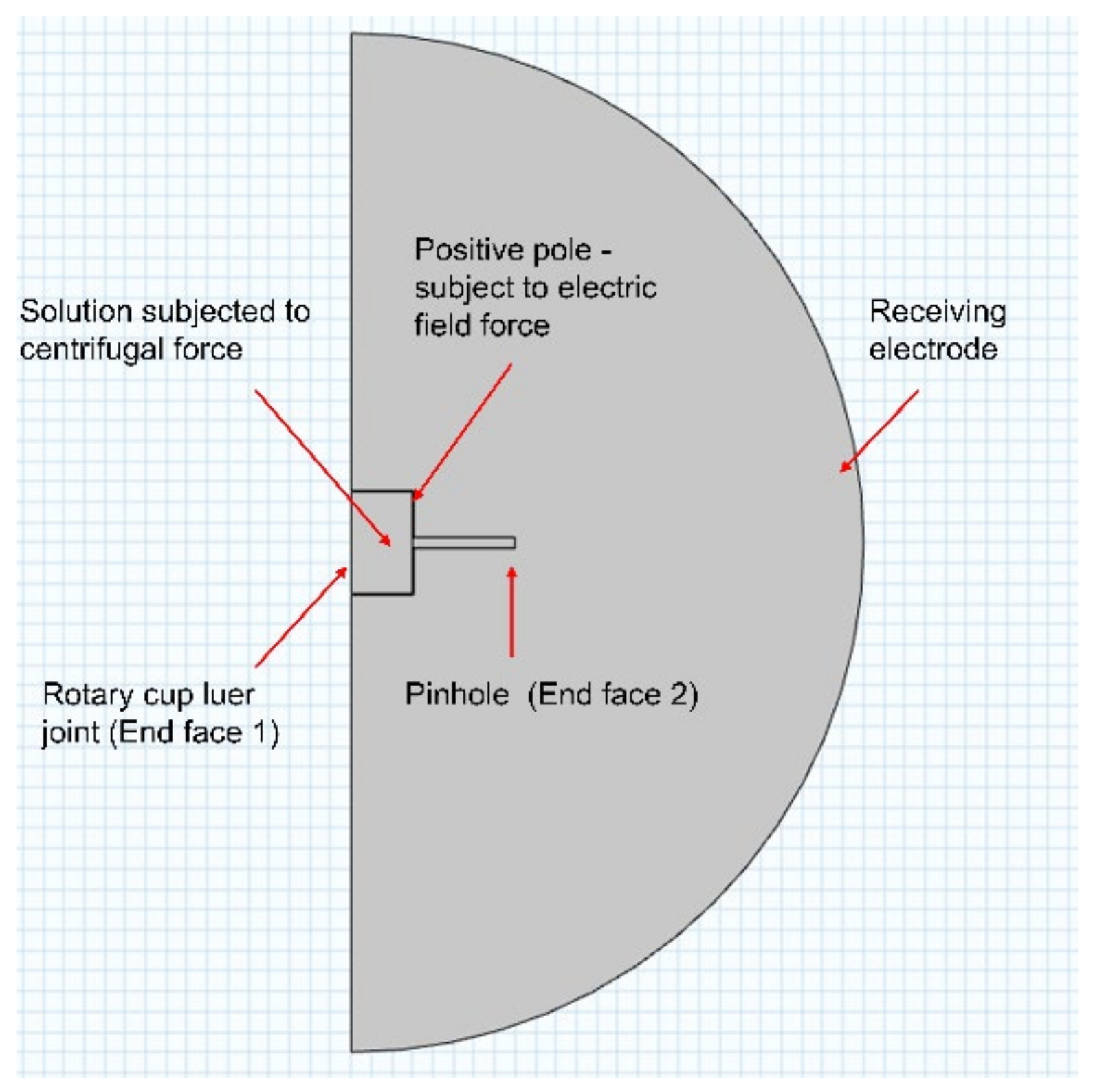




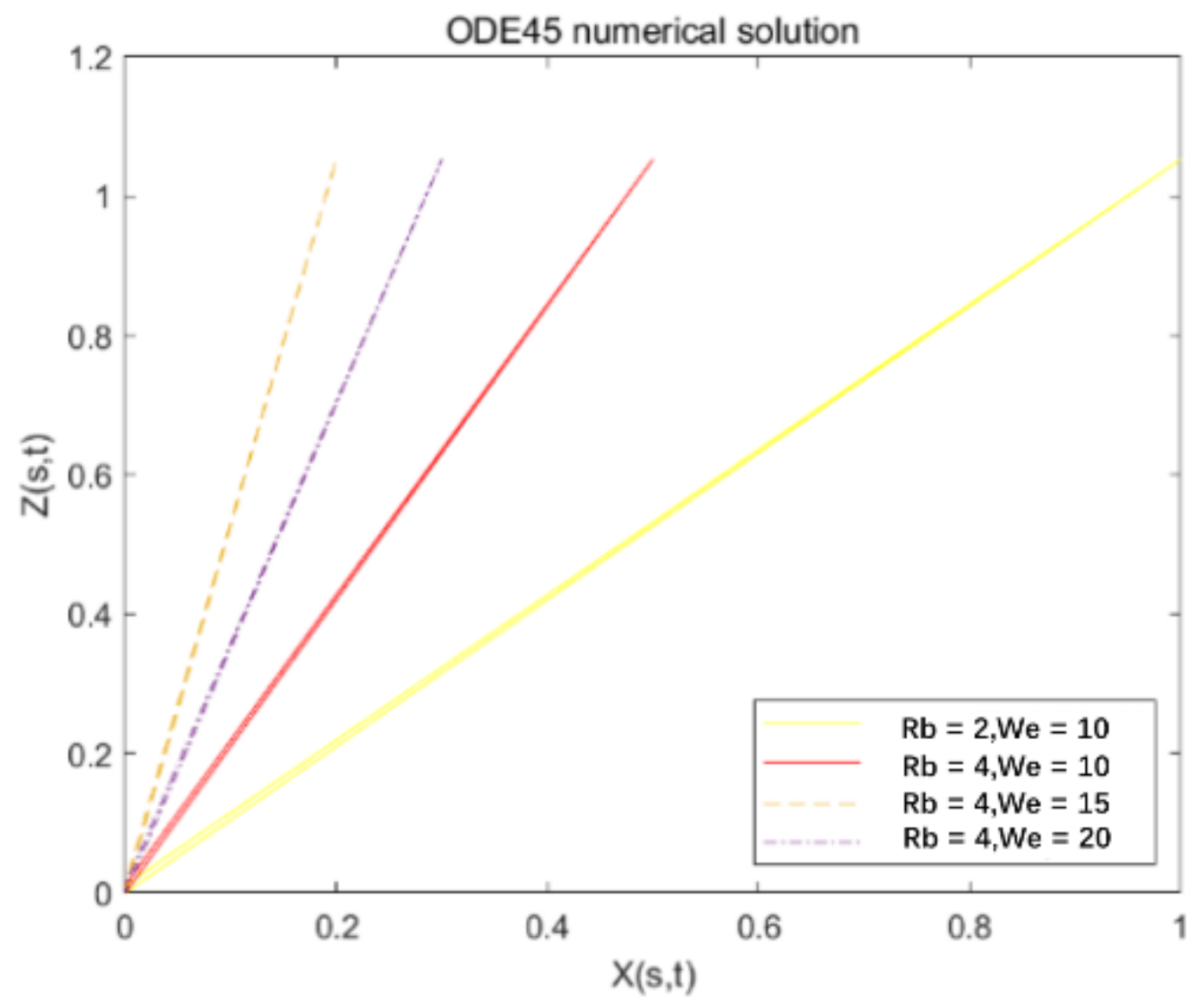
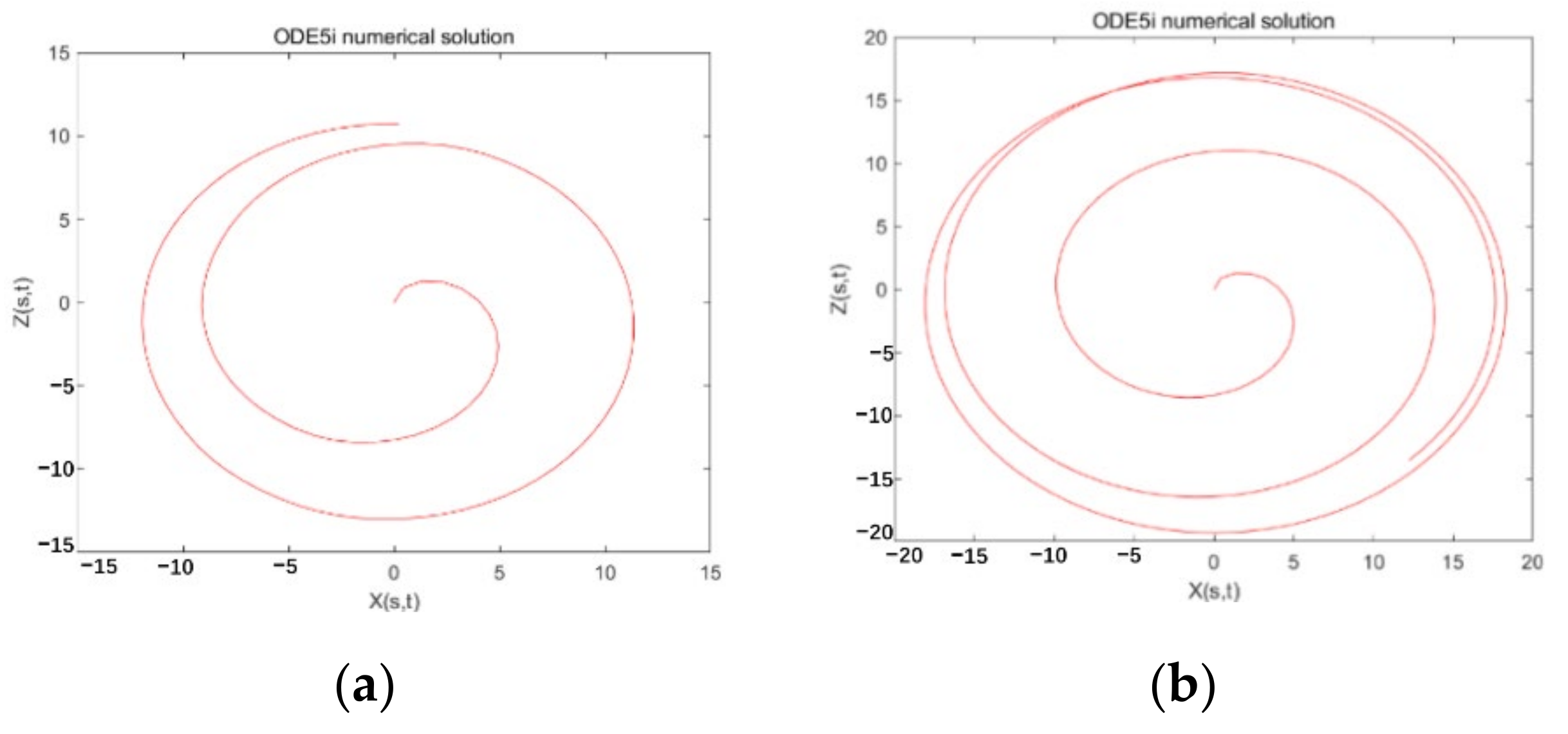
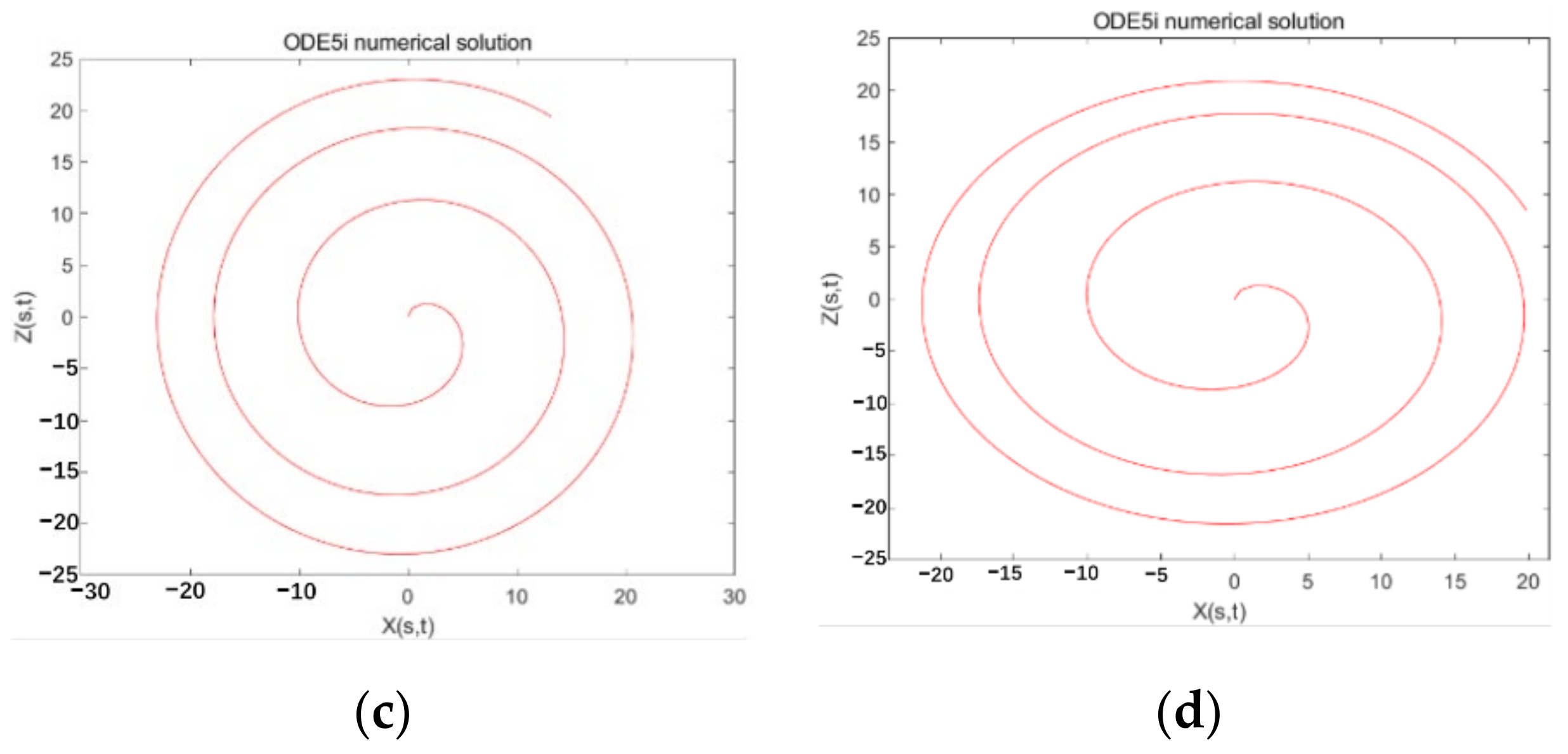
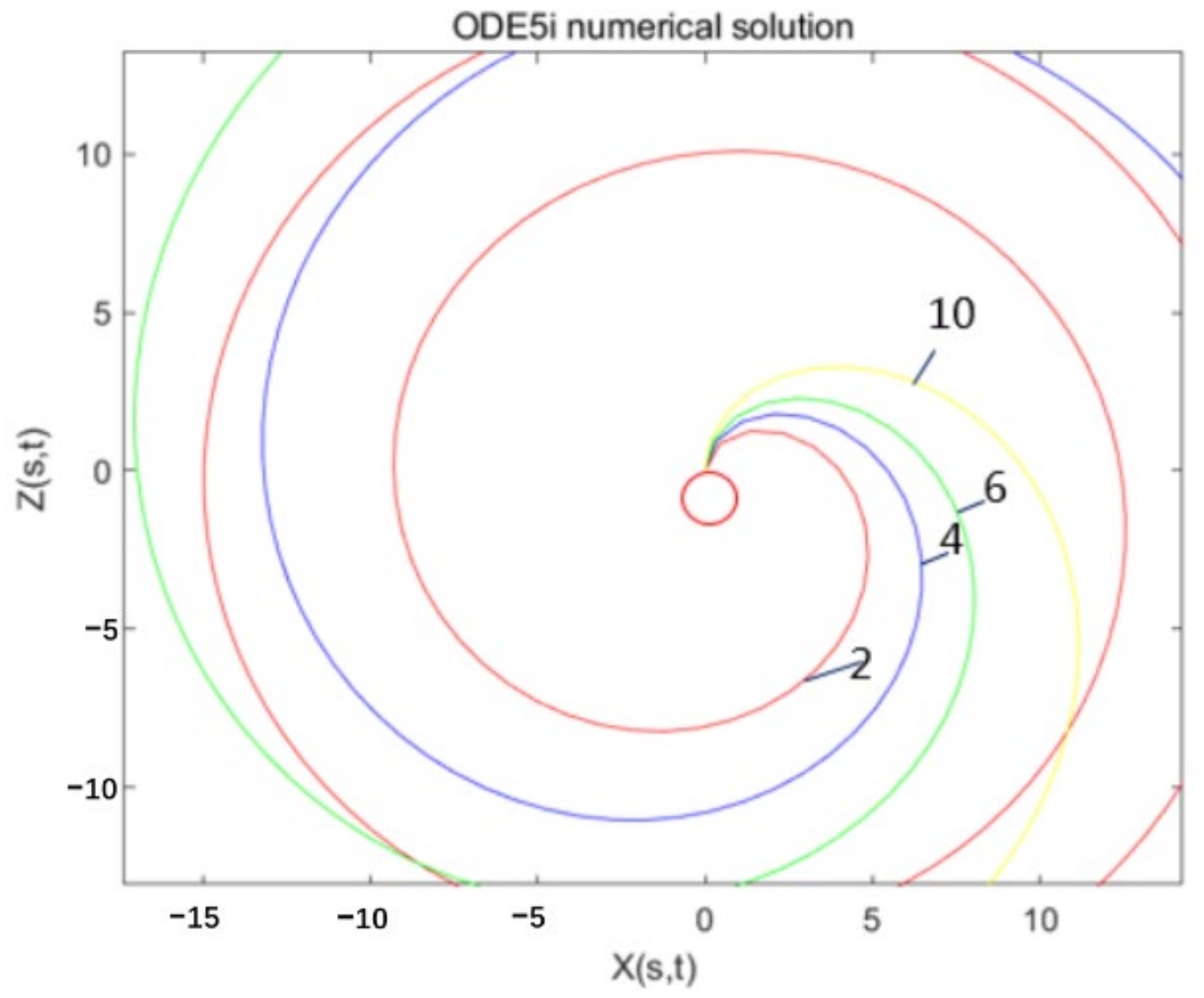
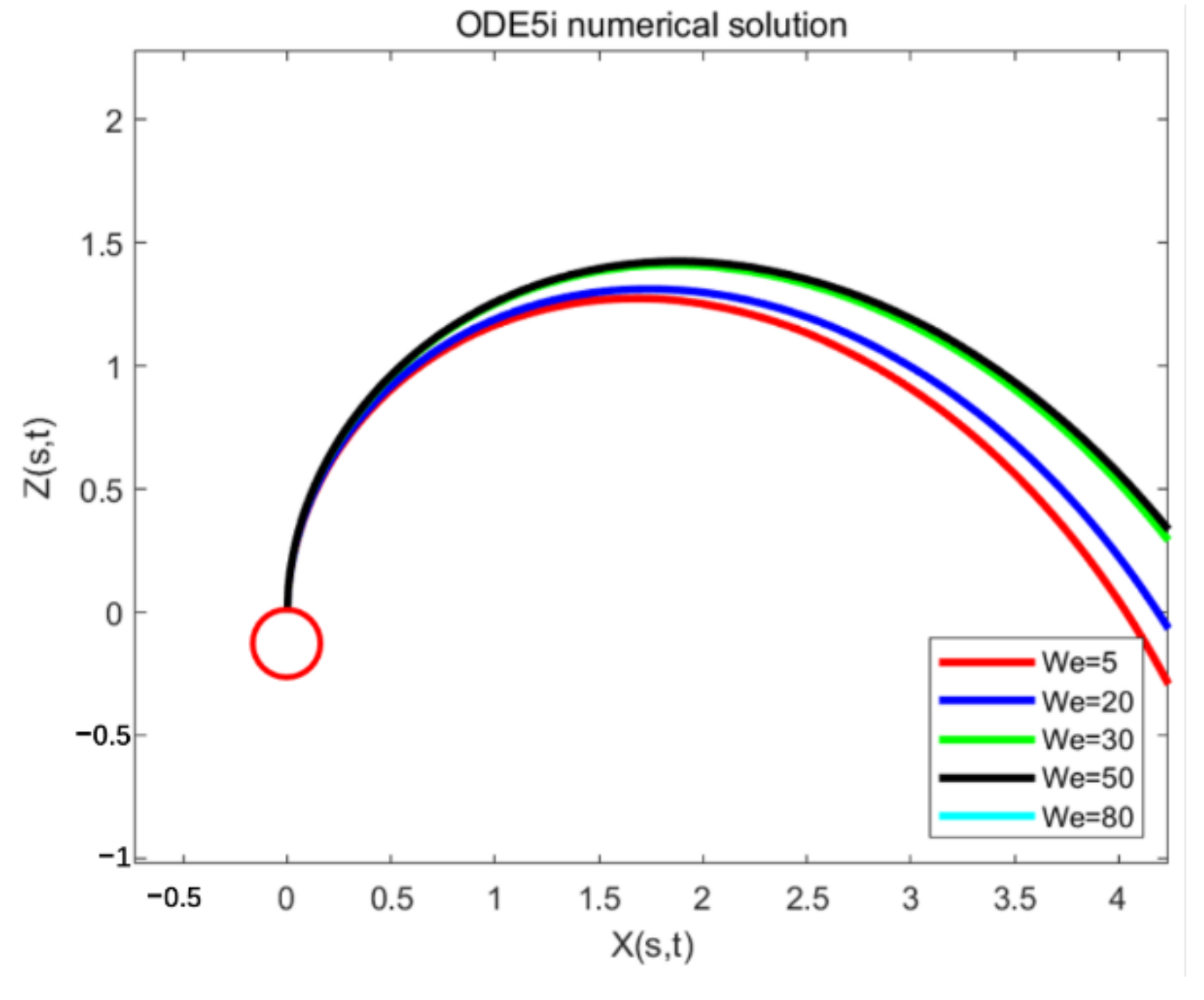


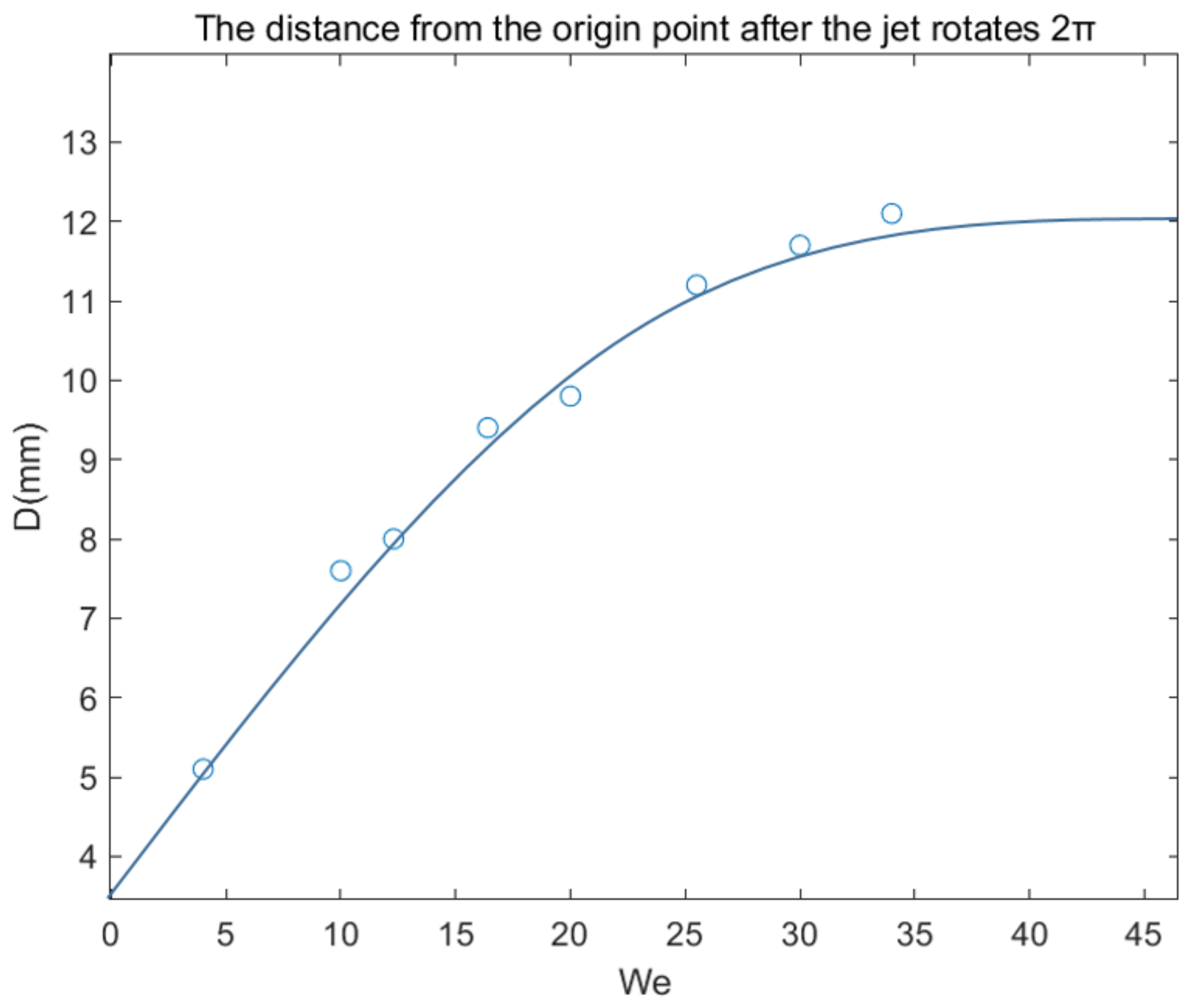
| Equipment | Manufacturers | Model Number | Specifications |
|---|---|---|---|
| Precision Gear Pump | MonyPumps (From Guangzhou, China) | M-60U2 | 0.001 mL/min~400 mL/min |
| LED Stroboscope | SuWei (From Guangzhou, China) | DW-P503-1ACDF | 60–499,999 Strobe/min |
| Accuracy: 0.001% | |||
| Illuminance: 1500LUX | |||
| Microscopic camera | FASTEC IMAGING (From San Diego, CA, USA) | Hispec5 | Pixel 1280 × 1024 |
| PEO | Dow | N3000 | 4,000,000 g/mol |
| Material | Mass Fraction | Electrical Conductivity (μs/cm) | Viscosity (mPa·s) | Surface Tension (mN/m) |
|---|---|---|---|---|
| PEO a | 4.50% | 76.8 | 2786 | 49.3 |
| PEO b | 5.50% | 83.2 | 4655 | 52.6 |
| PEO c | 6.50% | 85.4 | 10,000 | 68.9 |
| PEO d | 7.50% | 88.6 | 20,200 | 80.3 |
Publisher’s Note: MDPI stays neutral with regard to jurisdictional claims in published maps and institutional affiliations. |
© 2022 by the authors. Licensee MDPI, Basel, Switzerland. This article is an open access article distributed under the terms and conditions of the Creative Commons Attribution (CC BY) license (https://creativecommons.org/licenses/by/4.0/).
Share and Cite
Xu, G.; Zhou, B.; Guo, J.; Zeng, J.; Zhang, R.; Cai, N.; Li, Y.; Wu, P.; Chen, X.; Wang, H.; et al. Research on the Mechanism of Multi-Domain Coupling Centrifugal Electrostatic Blowing Flying Deposition. Micromachines 2022, 13, 1378. https://doi.org/10.3390/mi13091378
Xu G, Zhou B, Guo J, Zeng J, Zhang R, Cai N, Li Y, Wu P, Chen X, Wang H, et al. Research on the Mechanism of Multi-Domain Coupling Centrifugal Electrostatic Blowing Flying Deposition. Micromachines. 2022; 13(9):1378. https://doi.org/10.3390/mi13091378
Chicago/Turabian StyleXu, Guojie, Bei Zhou, Jian Guo, Jun Zeng, Rongguang Zhang, Nian Cai, Yongxing Li, Peixuan Wu, Xun Chen, Han Wang, and et al. 2022. "Research on the Mechanism of Multi-Domain Coupling Centrifugal Electrostatic Blowing Flying Deposition" Micromachines 13, no. 9: 1378. https://doi.org/10.3390/mi13091378






